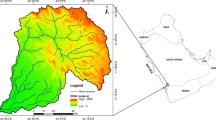Abstract
The Sidi Bouzid region is one of the main centers of agricultural production in Tunisia, based on groundwater. Therefore, a numerical regional hydrogeological model of the shallow aquifer of Sidi Bouzid was developed to estimate the regional impact of current and future groundwater use. A numerical flow model using a finite difference method and the Processing Modflow code version 5.3 was built for the steady state in the year 1989 and the transient conditions for the period 1989–2015. The developed numerical model was used to estimate the regional impact of current and future groundwater use. The addressed aspects, based on many hypotheses, consisted of natural recharge estimation, quantification of water budget, as well as the assessment of the impacts of overexploitation on the decrease of groundwater levels. A sensitivity analysis was also conducted in order to identify the most sensitive parameters in determining the aquifer behavior. The model parameters calibration was performed under steady-state flow conditions, and the simulations of groundwater flow were then performed under the stress conditions for the period 1989–2015. The simulations’ results showed a high decline of the piezometric levels from 1989 to 2015 that can be related to the weak and irregularity of precipitation in the study region as well as the groundwater overexploitation. This work has shown that the study area is now in a situation of water stress. It suffers from overexploitation conditions throughout the whole study area. Consequently, the Sidi Bouzid aquifer requires urgent action through good management, which consists of implementing a priority control plan for the pumping system. In the meantime, measures must be taken to reach an integrated management plan for the Sidi Bouzid aquifer.
Access this chapter
Tax calculation will be finalised at checkout
Purchases are for personal use only
Similar content being viewed by others
References
Amouri, M. (1994). Etude hydrogéologique du système aquifère de Sidi Bouzid. Rapport de Direction Générale des Ressources en Eau (DGRE).
Aydi, W., Saidi, S., Chalbaoui, M., Chaibi, S., & Ben Dhia, H. (2013). Evaluation of the groundwater vulnerability to pollution using an intrinsic and a specific method in a GIS environment: application to the plain of Sidi Bouzid (Central Tunisia). Arabian Journal for Science and Engineering, 38, 1815–1831. https://doi.org/10.1007/s13369-012-0417-9
Bédir, M., Tlig, S., Bobier, C., Zargouni, F., & Aïssaoui, N. (1996). Sequence stratigraphy, basin dynamics and petroleum geology of Miocene from the eastern Tunisia. Am Assoc Pet Geol Bull, 80(1), 63–81. In 9th International proceedings on proceedings (pp. 1–2).
CRDA (Commissariat régional du développement agricole de Sidi Bouzid) (2014). Données pluviométriques gouvernorat de Sidi Bouzid (unpubl.).
Khazri, D., & Gabtni, H. (2018). Geophysical methods integration for deep aquifer reservoir characterization and modeling (Sidi Bouzid basin, central Tunisia). Journal of African Earth Sciences, 138, 289–308. https://doi.org/10.1016/j.jafrearsci.2017.11.024
Lachaal, F., Mlayah, A., Anane, M., Bédir, M., Tarhouni, J., & Leduc, C. (2013). Comprehension and hydrogeological conceptualization of aquifer in arid and semi-arid regions using integrated hydrogeological information system: Case of the deep aquifer of Zéramdine-Béni Hassen (east-central Tunisia). Arabian Journal of Geosciences, 6, 2655–2671. https://doi.org/10.1007/s12517-011-0498-x
Simonot, M. (1995). Plaine de Sidi Bouzid: Etude de l’impact de l’épandage des crues sur le recharge de la nappe phréatique. Rapport DGRE.
Smida, H. (2008). Apports des Systèmes d’Informations Géographiques (SIG) pour une approche intégrée dans l’étude et la gestion des ressources en eau des systèmes aquifères de la région de Sidi Bouzid (Tunisie centrale). Thèse Troisième Cycle, Univ.
Yangui, H., Zouari, K., Trabelsi, R., & Rozanski, K. (2011). Recharge mode and mineralization of groundwater in a semi-arid region: Sidi Bouzid plain (central Tunisia). Environmental Earth Sciences, 63, 969–979. https://doi.org/10.1007/s12665-010-0771-4
Author information
Authors and Affiliations
Corresponding author
Editor information
Editors and Affiliations
Rights and permissions
Copyright information
© 2023 The Author(s), under exclusive license to Springer Nature Switzerland AG
About this paper
Cite this paper
Gharbi, A., IbnAli, Z., Abidi, M., Kammoun, A., Zairi, M. (2023). Conceptual and Numerical Hydrogeological Modeling of the Shallow Aquifer of Sidi Bouzid: Discussion of the Different Hypothesis. In: Kallel, A., et al. Selected Studies in Environmental Geosciences and Hydrogeosciences. CAJG 2020. Advances in Science, Technology & Innovation. Springer, Cham. https://doi.org/10.1007/978-3-031-43803-5_47
Download citation
DOI: https://doi.org/10.1007/978-3-031-43803-5_47
Published:
Publisher Name: Springer, Cham
Print ISBN: 978-3-031-43802-8
Online ISBN: 978-3-031-43803-5
eBook Packages: Earth and Environmental ScienceEarth and Environmental Science (R0)




